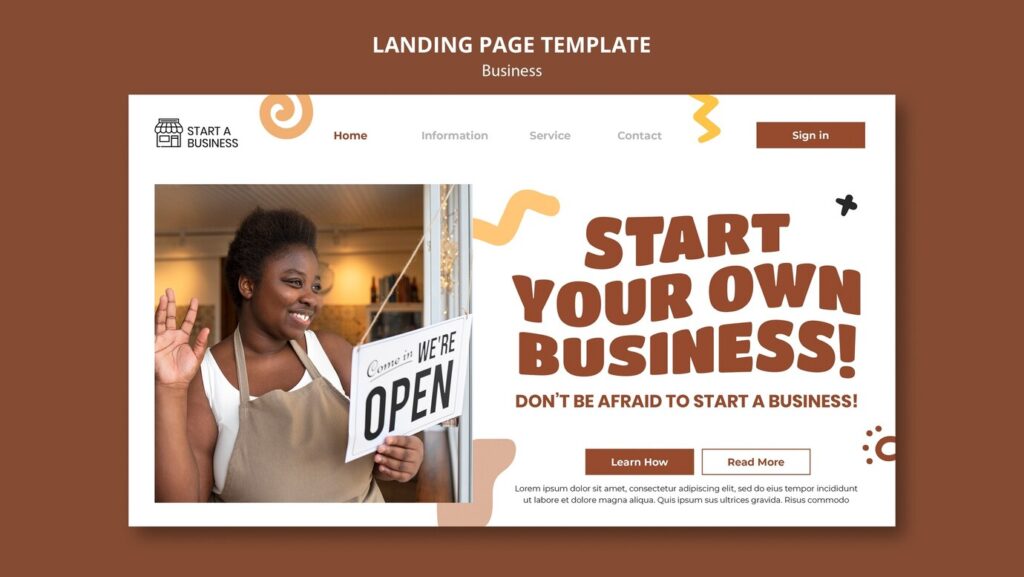In today’s digital age, having a website is essential for the success of any small business. It helps establish credibility, attract customers, and showcase your products or services. If you are looking for tips on how to design a website for small business owners in the UK, this comprehensive guide will walk you through the steps you need to follow to create a professional and user-friendly website that effectively represents your brand.
Why Having a Website is Crucial for Small Businesses in the UK
A website is more than just an online presence; it’s a powerful marketing tool. For small businesses in the UK, a well-designed website can help you:
- Establish Credibility: A professional website boosts trust with potential customers.
- Expand Reach: Your business is no longer limited to foot traffic—customers can find you online.
- Showcase Your Products/Services: A website allows you to display your offerings in an attractive, informative way.
- Generate Leads and Sales: A well-optimized website can increase conversions and drive sales.
10 Essential Steps for Small Business Owners to Design a Website
Step 1: Choose a Domain Name and Hosting Provider
The first step to designing a website is selecting a domain name that reflects your business and is easy to remember. Your domain name should be:
- Short and memorable: Aim for a name that’s easy to type and remember.
- Relevant to your business: Try to include your business name or the products/services you offer.
- Unique: Ensure your domain name isn’t already in use or too similar to existing businesses.
After securing a domain name, choose a hosting provider. Some popular hosting platforms in the UK include:
- SiteGround
- Bluehost
- HostGator
- Kinsta
Step 2: Pick a Website Builder or Hire a Web Designer
If you’re tech-savvy, you might want to design your website yourself using a website builder. Popular website builders for small businesses in the UK include:
- Wix: Easy to use with drag-and-drop functionality.
- Squarespace: Known for its sleek templates and creative designs.
- WordPress: Offers more flexibility, ideal for businesses looking for customization.
If you prefer a professional touch, consider hiring a website designer or agency. Freelance web designers in the UK, such as those found on Hayanow, can help create a website tailored to your specific business needs.
RECOMMENDED READ: How to Hire a Website Designer in the UK: A Step-by-Step Guide to Finding the Perfect Fit
Step 3: Design Your Website with Your Audience in Mind
When designing your website, keep your target audience in mind. Consider the following:
- User-Friendly Navigation: Ensure your website is easy to navigate. Customers should be able to find information within a few clicks.
- Mobile Optimization: With more consumers browsing and shopping on mobile devices, ensure your website is responsive and looks great on smartphones and tablets.
- Professional Design: Use high-quality images, easy-to-read fonts, and a clean layout. Consistent branding and design elements enhance your business’s credibility.
- Clear Call-to-Actions (CTAs): Guide visitors on what action to take, such as contacting you, signing up for your newsletter, or purchasing a product.
Step 4: Create Compelling Content
Content is king when it comes to engaging your audience. Ensure your website’s content speaks to your target customers’ needs and pain points. Key pages to include on your small business website:
- Home Page: A brief overview of your business and services.
- About Us: Information about your business’s background and values.
- Services/Products Page: Detailed descriptions of what you offer.
- Blog: Share helpful tips, industry news, or product updates (great for SEO).
- Contact Page: Make it easy for customers to get in touch with you.
Step 5: Optimize Your Website for Search Engines (SEO)
SEO is essential for driving organic traffic to your website. Focus on:
- Keywords: Use relevant keywords related to your business in your content (e.g., “plumbing services in London” or “best web design in Manchester”).
- Meta Descriptions: Write concise and engaging meta descriptions for each page.
- Alt Text for Images: Optimize images by adding alt text that includes keywords.
- Local SEO: If you’re targeting customers in the UK, include local keywords and register your business with Google My Business.
Step 6: Set Up E-commerce (If Applicable)
If you’re selling products online, integrating an e-commerce platform is essential. Some options include:
- WooCommerce: Perfect for WordPress users looking to sell products online.
- Shopify: A popular platform for small businesses to create an online store.
- BigCommerce: Offers a variety of tools for e-commerce growth.
Ensure your e-commerce site is secure (use SSL certificates) and offers a smooth shopping experience.
Step 7: Test Your Website
Before launching, thoroughly test your website to ensure it works as expected. Check for:
- Broken links: Ensure all links lead to the correct pages.
- Fast Load Times: Use tools like Google PageSpeed Insights to check your site’s load speed.
- Mobile Responsiveness: Ensure your site looks great on various devices.
- Forms and Payment Options: Test contact forms and payment gateways to ensure they function properly.
Step 8: Launch and Promote Your Website
Once you’re happy with your website, it’s time to launch! After launching, promote your website through various channels:
- Social Media: Share your website on social media platforms like Facebook, Instagram, and LinkedIn.
- Email Marketing: Send a launch email to your existing customers or subscribers.
- Google Ads: Consider using Google Ads to drive traffic to your site.
- Networking: Reach out to local businesses and communities to help spread the word.
Step 9: Regularly Update and Maintain Your Website
Your website is not a one-time project—it’s an ongoing tool for your business. Regularly update your content, add new products or services, and maintain your site to ensure it stays fresh and functional.
Step 10: Leverage Experts for Your Website Design Needs
While it’s possible to design a website on your own using a website builder, working with professionals can take your website to the next level. Leveraging experts, such as those available on Hayanow, can provide you with the expertise and technical know-how to ensure your website looks professional, functions flawlessly, and effectively meets the needs of your business. By hiring a skilled website designer, you save time and gain access to the latest web design trends, SEO practices, and custom solutions tailored to your business goals.



